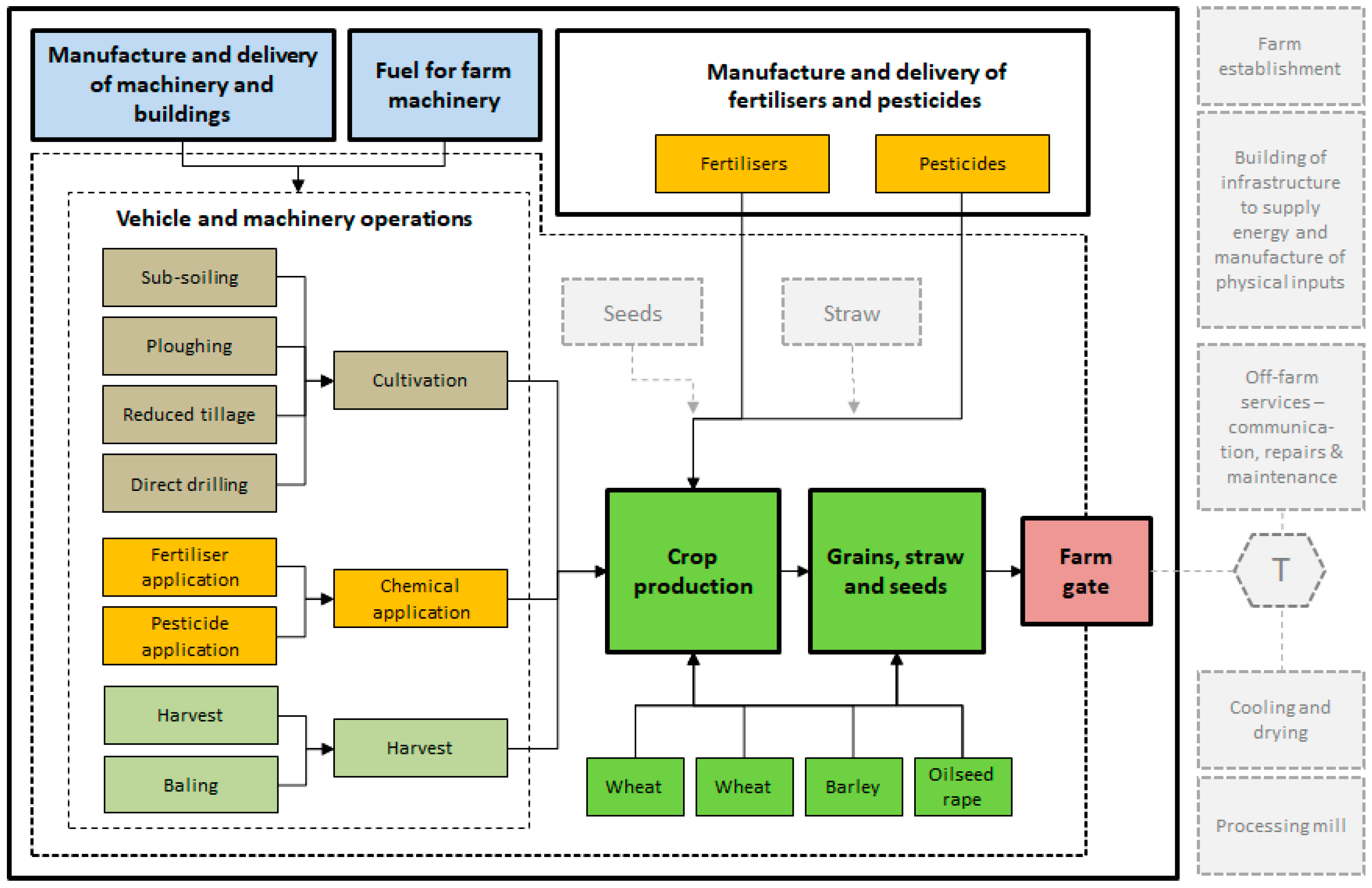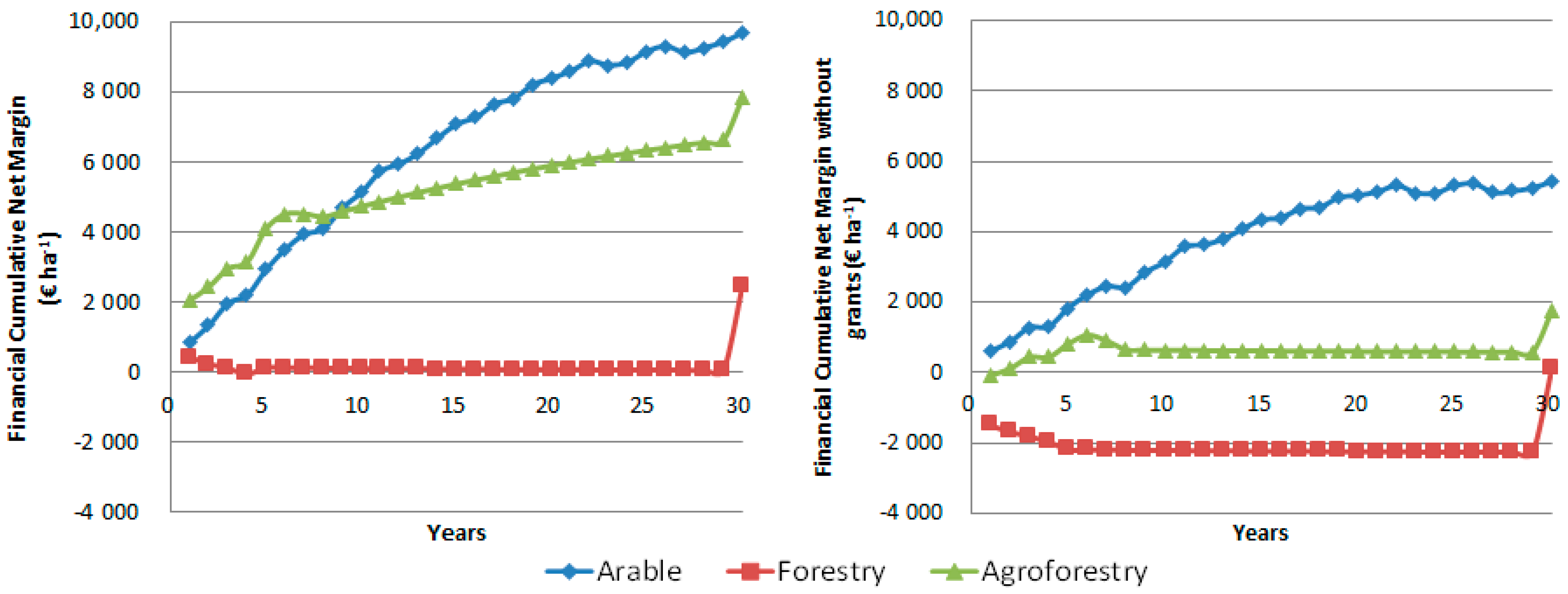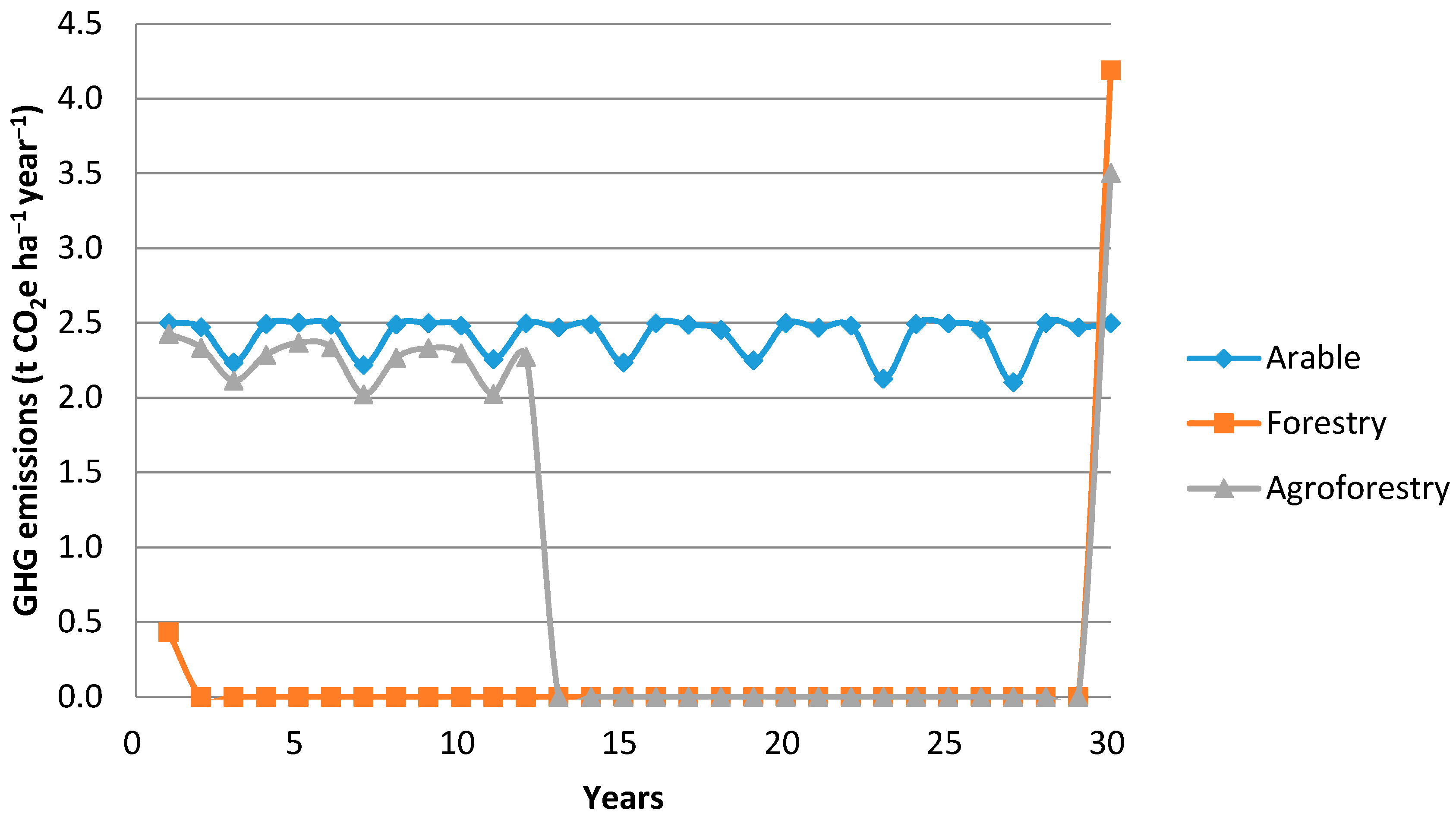Assessing the Impact of Greenhouse Gas Emissions on Economic Profitability of Arable, Forestry, and Silvoarable Systems
Abstract
:1. Introduction
2. Method
2.1. Case Study Description
- Arable: A four-year rotation of autumn sown winter wheat (feed), winter wheat (feed), winter barley (feed), and winter oilseed rape over a time horizon of 30 years.
- Forestry: A poplar (Populus spp.) hybrid (Beaupré) over a rotation of 30 years.
- Agroforestry: Silvoarable system with the poplar (Populus spp.) hybrid (Beaupré) over a rotation of 30 years and a four-year crop rotation identical to that of the arable system.
2.2. Input Data
2.2.1. Biophysical Data
2.2.2. Financial Data
2.2.3. Life-Cycle Data
2.3. Model Development
2.3.1. Financial Appraisal
2.3.2. GHG Emissions and Sequestration in the Farm-SAFE Model
2.3.3. Greenhouse Gas Emissions in the LCA


Aboveground-Biomass Carbon Sequestration
- Conversion of fresh timber volume into dry timber mass. Since the Yield-SAFE model provides timber volume predictions, this needed to be converted into a timber mass. This was done using a wood density value for poplars from Dryad [47] of 0.353 t m−3.
- Conversion of carbon into CO2e was done by scaling the molecular mass of carbon dioxide (44) to the atomic mass of carbon (12) in tree biomass. Thus, 1 kg of carbon taken up into biomass is equivalent to an emission of 3.67 kg CO2e.
2.3.4. Economic Appraisal
3. Results
3.1. Financial Appraisal
3.2. GHG Emissions and Carbon Sequestration
3.2.1. GHG Emissions
3.2.2. Above-Ground Carbon Sequestration and GHG Balance
3.3. Economic Appraisal
4. Discussion
5. Conclusions
Author Contributions
Funding
Institutional Review Board Statement
Informed Consent Statement
Data Availability Statement
Conflicts of Interest
References
- IPCC. Climate Change 2014: Synthesis Report. Contribution of Working Groups I, II and III to the Fifth Assessment Report of the Intergovernmental Panel on Climate Change; Core Writing Team, Pachauri, R.K., Meyer, L.A., Eds.; IPCC: Geneva, Switzerland, 2014; p. 151. [Google Scholar]
- Gilbert, N. One-third of our greenhouse gas emissions come from agriculture. Nat. Cell Biol. 2012. [Google Scholar] [CrossRef]
- Uphoff, N. Agroecological Approaches to Help “Climate Proof” Agriculture While Raising Productivity in the Twenty-First Century. In Sustaining Soil Productivity in Response to Global Climate Change; Wiley: Chichester, UK, 2011; pp. 87–102. [Google Scholar]
- Dupraz, C.; Burgess, P.; Gavaland, A.; Graves, A.; Herzog, F.; Incoll, L.D.; Jackson, N.; Keesman, K.; Lawson, G.; Lecomte, I.; et al. SAFE Final Report—Synthesis of the Silvoarable Agroforestry for Europe Project; INRA-UMR System Editions: Montpellier, France, 2005. [Google Scholar]
- Quinkenstein, A.; Wöllecke, J.; Böhm, C.; Grünewald, H.; Freese, D.; Schneider, B.U.; Hüttl, R.F. Ecological benefits of the alley cropping agroforestry system in sensitive regions of Europe. Environ. Sci. Policy 2009, 12, 1112–1121. [Google Scholar] [CrossRef]
- Nemecek, T.; Dubois, D.; Huguenin-Elie, O.; Gaillard, G. Life cycle assessment of Swiss farming systems: I. Integrated and organic farming. Agric. Syst. 2011, 104, 217–232. [Google Scholar] [CrossRef]
- Nemecek, T.; Huguenin-Elie, O.; Dubois, D.; Gaillard, G.; Schaller, B.; Chervet, A. Life cycle assessment of Swiss farming systems: II. Extensive and intensive production. Agric. Syst. 2011, 104, 233–245. [Google Scholar] [CrossRef]
- Palma, J.; Graves, A.; Bunce, R.; Burgess, P.; de Filippi, R.; Keesman, K.; van Keulen, H.; Liagre, F.; Mayus, M.; Moreno, G.; et al. Modeling environmental benefits of silvoarable agroforestry in Europe. Agric. Ecosyst. Environ. 2007, 119, 320–334. [Google Scholar] [CrossRef] [Green Version]
- European Commission. EU Greenhouse Gas Emissions and Targets. Available online: https://ec.europa.eu/clima/policies/strategies/progress/monitoring_en (accessed on 26 February 2021).
- Renzulli, P.A.; Bacenetti, J.; Benedetto, G.; Fusi, A.; Ioppolo, G.; Niero, M.; Proto, M.; Salomone, R.; Sica, D.; Supino, S. Life Cycle Assessment in the Cereal and Derived Products Sector. In Life Cycle Assessment in the Agri-Food Sector; Springer International Publishing: Cham, Switzerland, 2015; pp. 185–249. [Google Scholar]
- Clay, D.; Ottawa, A.; Flores, L.; Delucco, P.; Kacou, E.; Foster, J.; Baffes, J.; Rajadel, T. Export Crops: Toward a Significant Contribution to Growth. In Breaking the Cycle A Strategy for Conflict—Sensitive Rural Growth in Burundi; Baghdadli, I., Harborne, B., Rajadel, T., Eds.; World Bank Working Paper No. 147; World Bank Publications: Washington, DC, USA, 2008. [Google Scholar]
- Tilman, D.; Cassman, K.G.; Matson, P.A.; Naylor, R.; Polasky, S. Agricultural sustainability and intensive production practices. Nature 2002, 418, 671–677. [Google Scholar] [CrossRef] [PubMed]
- Smith, J.; Pearce, B.D.; Wolfe, M.S. Reconciling productivity with protection of the environment: Is temperate agroforestry the answer? Renew. Agric. Food Syst. 2012, 28, 1–13. [Google Scholar] [CrossRef]
- Thornton, P.K. Recalibrating Food Production in the Developing World: Global Warming Will Change More Than Just the Climate; CGIAR Research Program on Climate Change, Agriculture and Food Security: Wageningen, The Netherlands, 2012; p. 16. [Google Scholar]
- Aertsens, J.; de Nocker, L.; Gobin, A. Valuing the carbon sequestration potential for European agriculture. Land Use Policy 2013, 31, 584–594. [Google Scholar] [CrossRef]
- McAdam, J.H.; Burgess, P.J.; Graves, A.R.; Rigueiro-Rodríguez, A.; Mosquera-Losada, M.R. Classifications and Functions of Agroforestry Systems in Europe. In Agroforestry in Europe: Current Status and Future Prospects; Springer Netherlands: Dordrecht, The Netherlands, 2009; pp. 21–41. [Google Scholar]
- Jose, S. Agroforestry for ecosystem services and environmental benefits: An overview. Agrofor. Syst. 2009, 76, 1–10. [Google Scholar] [CrossRef]
- Mosquera-Losada, M.R.; McAdam, J.H.; Romero-Franco, R.; Santiago-Freijanes, J.J.; Rigueiro-Rodróguez, A. Definitions and Components of Agroforestry Practices in Europe. In Agroforestry in Europe: Current Status and Future Prospects; Springer Netherlands: Dordrecht, The Netherlands, 2009; pp. 3–19. [Google Scholar]
- Nair, P.K.R.; Kumar, B.M.; Nair, V.D. Agroforestry as a strategy for carbon sequestration. J. Plant Nutr. Soil Sci. 2009, 172, 10–23. [Google Scholar] [CrossRef]
- Nair, P.R.; Nair, V.D. ‘Solid–fluid–gas’: The state of knowledge on carbon-sequestration potential of agroforestry systems in Africa. Curr. Opin. Environ. Sustain. 2014, 6, 22–27. [Google Scholar] [CrossRef] [Green Version]
- Nair, P.K.R. Agroforestry Systems and Environmental Quality: Introduction. J. Environ. Qual. 2011, 40, 784–790. [Google Scholar] [CrossRef] [PubMed] [Green Version]
- Angus, A.; Burgess, P.; Morris, J.; Lingard, J. Agriculture and land use: Demand for and supply of agricultural commodities, characteristics of the farming and food industries, and implications for land use in the UK. Land Use Policy 2009, 26, S230–S242. [Google Scholar] [CrossRef]
- Graves, A.R. Bio-Economic Evaluation of Agroforestry Systems for Europe. Ph.D. Thesis, Institute of Water and Environment, Cranfield University, Silsoe, Bedfordshire, UK, 2005. [Google Scholar]
- Haas, G.; Wetterich, F.; Köpke, U. Comparing intensive, extensified and organic grassland farming in southern Germany by process life cycle assessment. Agric. Ecosyst. Environ. 2001, 83, 43–53. [Google Scholar] [CrossRef] [Green Version]
- Williams, A.G.; Audsley, E.; Sandars, D.L. Environmental burdens of producing bread wheat, oilseed rape and potatoes in England and Wales using simulation and system modelling. Int. J. Life Cycle Assess. 2010, 15, 855–868. [Google Scholar] [CrossRef] [Green Version]
- British Standards Institution. PAS 2050—Specification for the Assessment of the Life Cycle Greenhouse Gas Emissions of Goods and Services; British Standards Institution: London, UK, 2011. [Google Scholar]
- Goglio, P.; Brankatschk, G.; Knudsen, M.T.; Williams, A.G.; Nemecek, T. Addressing crop interactions within cropping systems in LCA. Int. J. Life Cycle Assess. 2018, 23, 1735–1743. [Google Scholar] [CrossRef] [Green Version]
- González-García, S.; Krowas, I.; Becker, G.; Feijoo, G.; Moreira, M.T. Cradle-to-gate life cycle inventory and environmental performance of Douglas-fir roundwood production in Germany. J. Clean. Prod. 2013, 54, 244–252. [Google Scholar] [CrossRef]
- González-García, S.; Moreira, M.T.; Dias, A.C.; Mola-Yudego, B. Cradle-to-gate Life Cycle Assessment of forest operations in Europe: Environmental and energy profiles. J. Clean. Prod. 2014, 66, 188–198. [Google Scholar] [CrossRef]
- Klein, D.; Wolf, C.; Schulz, C.; Weber-Blaschke, G. 20 years of life cycle assessment (LCA) in the forestry sector: State of the art and a methodical proposal for the LCA of forest production. Int. J. Life Cycle Assess. 2015, 20, 556–575. [Google Scholar] [CrossRef]
- Murphy, F.; Devlin, G.; Mcdonnell, K. Energy requirements and environmental impacts associated with the production of short rotation willow (Salix sp.) chip in Ireland. GCB Bioenergy 2013, 6, 727–739. [Google Scholar] [CrossRef] [Green Version]
- Murphy, F.; Devlin, G.; McDonnell, K.T. Forest biomass supply chains in Ireland: A life cycle assessment of GHG emissions and primary energy balances. Appl. Energy 2014, 116, 1–8. [Google Scholar] [CrossRef] [Green Version]
- Rives, J.; Fernandez-Rodriguez, I.; Rieradevall, J.; Gabarrell, X.; Durany, X.G. Environmental analysis of raw cork extraction in cork oak forests in southern Europe (Catalonia-Spain). J. Environ. Manag. 2012, 110, 236–245. [Google Scholar] [CrossRef]
- Burgess, P.J.; Incoll, L.D.; Hart, B.J.; Beaton, A.; Piper, R.W.; Seymour, I.; Reynolds, F.H.; Wright, C.; Pilbeam, D.J.; Graves, A.R. The Impact of Silvoarable Agroforestry with Poplar on Farm Profitability and Biological Diversity; DEFRA: Silsoe, UK, 2003.
- van Der Werf, W.; Keesman, K.; Burgess, P.J.; Graves, A.R.; Pilbeam, D.; Incoll, L.D.; Metselaar, K.; Mayus, M.; Stappers, R.; van Keulen, H.; et al. Yield-SAFE: A parameter-sparse, process-based dynamic model for predicting resource capture, growth, and production in agroforestry systems. Ecol. Eng. 2007, 29, 419–433. [Google Scholar] [CrossRef] [Green Version]
- Agro Business Consultants. The Agricultural Budgeting & Costing Book, 80th ed.; Agro Business Consultants: Melton Mowbray, UK, 2015. [Google Scholar]
- Savill, P.S. The Silviculture of Trees Used in British Forestry; CABI: Wallingford, Oxon, UK, 1991. [Google Scholar]
- Morison, J.; Matthews, R.; Miller, G.; Perks, M.; Randle, T.; Vanguelova, E.; White, M.; Yamulki, S. Understanding the Carbon and Greenhouse Gas Balance of Forests in Britain; Forestry Commission Research Report; Forestry Commission: Edinburgh, UK, 2012.
- Karjalainen, T.; Asikainen, A. Greenhouse gas emissions from the use of primary energy in forest operations and long-distance transportation of timber in Finland. Forestry 1996, 69, 216–228. [Google Scholar] [CrossRef]
- Graves, A.R.; Burgess, P.J.; Herzog, F.; Palma, J. Farm-SAFE 2006 User Manual; Cranfield University: Cranfield, Bedfordshire, UK, 2006. [Google Scholar]
- Boardman, A.E.; Greenberg, D.H.; Vining, A.R.; Weimer, D.L. Cost-Benefit Analysis: Concepts and Practice, 4th ed.; Pearson: Upper Saddle River, NJ, USA, 2011. [Google Scholar]
- Graves, A.R.; Burgess, P.J.; Palma, J.H.N.; Herzog, F.; Moreno, G.; Bertomeu, M.; Dupraz, C.; Liagre, F.; Keesman, K.; van der Werf, W.; et al. Development and application of bioeconomic modelling to compare silvoarable, arable, and forestry systems in three European countries. Ecol. Eng. 2007, 29, 434–449. [Google Scholar] [CrossRef] [Green Version]
- Campbell, H.F.; Brown, R.P.C. Benefit-Cost Analysis: Financial and Economic Appraisal Using Spreadsheets; Cambridge University Press: Cambridge, UK, 2003. [Google Scholar]
- Audsley, E.; Alber, S.; Clift, R.; Cowell, S.; Crettaz, P.; Gaillard, G.; Hausheer, J.; Jolliett, O.; Kleijn, R.; Mortensen, B.; et al. Harmonisation of Environmental Life Cycle Assessment for Agriculture; Final Report, concerted action AIR-3CT94-2028; Silsoe Research Institute: Silsoe, UK, 1997. [Google Scholar]
- Kaske, K.J. Development of An Integrated Economic Model for the Assessment of the Environmental Burden of Arable, Forestry and Silvoarable Systems. Master’s Thesis, Cranfield University, Cranfield, Bedfordshire, UK, 2015. [Google Scholar]
- Forrest, M. Landscape Trees and Shrubs: Selection, Use and Management; CABI: Oxon, UK, 2006. [Google Scholar]
- Dryad. Global Wood Density Database; Dryad: Alexandria, VA, USA, 2009. [Google Scholar] [CrossRef]
- BEIS. Updated Short-Term Traded Carbon Values Used for UK Public Policy Appraisal. Available online: https://www.gov.uk/government/collections/carbon-valuation--2#update-to-traded-carbon-values:-2018 (accessed on 26 February 2021).
- Forestry Commission. The Woodland Carbon Code. A Buyers’ Guide to Woodland Carbon Units. Available online: https://www.woodlandcarboncode.org.uk/images/PDFs/Woodland_Carbon_Code_BuyersGuide_links.pdf (accessed on 19 September 2020).
- Treasury, H.M. The Green Book: Appraisal and Evaluation in Central Government; HM Treasury and Government Finance Function: London, UK, 2003.
- Giannitsopoulos, M.L.; Graves, A.R.; Burgess, P.J.; Crous-Duran, J.; Moreno, G.; Herzog, F.; Palma, J.H.; Kay, S.; de Jalón, S.G. Whole system valuation of agroforestry, arable, and tree-only systems at three case study sites in Europe. J. Clean. Prod. 2020, 269, 122283. [Google Scholar] [CrossRef]
- García de Jalón, S.; Graves, A.; Palma, J.H.N.; Williams, A.; Upson, M.; Burgess, P.J. Modelling and valuing the environmental impacts of arable, forestry and agroforestry systems: A case study. Agrofor. Syst. 2018, 92, 1059–1073. [Google Scholar] [CrossRef] [Green Version]
- Kay, S.; Rega, C.; Moreno, G.; den Herder, M.; Palma, J.H.N.; Borek, R.; Crous-Duran, J.; Freese, D.; Giannitsopoulos, M.; Graves, A.R.; et al. Agroforestry creates carbon sinks whilst enhancing the environment in agricultural landscapes in Europe. Land Use Policy 2019, 83, 581–593. [Google Scholar] [CrossRef]
- Fagerholm, N.M.; Torral, G.; Moreno, M.; Girardello, F.; Herzog, S.; Aviron, P.J.; Burgess, J.; Crous-Duran, N.; Ferreiro-Domínguez, A.R.; Graves, A.; et al. Cross-site analysis of perceived ecosystem service benefits in multifunctional landscapes. Glob. Environ. Chang. 2019, 56, 134–147. [Google Scholar] [CrossRef] [Green Version]
- Lippke, B.; Oneil, E.; Harrison, R.; E Skog, K.; Gustavsson, L.; Sathre, R. Life cycle impacts of forest management and wood utilization on carbon mitigation: Knowns and unknowns. Carbon Manag. 2011, 2, 303–333. [Google Scholar] [CrossRef]
- Danso, S.K.A.; Bowen, G.D.; Sanginga, N. Biological nitrogen fixation in trees in agro-ecosystems. Plant Soil 1992, 141, 177–196. [Google Scholar] [CrossRef]
- Dommergues, Y.R. The Role of Biological Nitrogen Fixation in Agroforestry. In Agroforestry: A Decade of Development; Steppler, H.A., Nair, P.K.R., Eds.; International Council for Research in Agroforestry (ICRAF): Nairobi, Kenya, 1987; pp. 245–271. [Google Scholar]
- Ahirwal, J.; Maiti, S.K. Carbon Sequestration and Soil CO2 Flux in Reclaimed Coal Mine Land from India. In Bio-Geotechnologies for Mine Site Rehabilitation; Prasad, M.N.V., de Campos Favas, P.J., Maiti, S.K., Eds.; Elesevier: Amsterdam, The Netherlands, 2018; p. 730. [Google Scholar]
- Lal, R. Forest soils and carbon sequestration. For. Ecol. Manag. 2005, 220, 242–258. [Google Scholar] [CrossRef]
- Smith, P. Carbon sequestration in croplands: The potential in Europe and the global context. Eur. J. Agron. 2004, 20, 229–236. [Google Scholar] [CrossRef]
- Jenssen, T.K.; Kongshaug, G. Energy Consumption and Greenhouse Gas Emissions in Fertiliser Production. IFS Proceeding Number 509; The International Fertiliser Society: York, UK, 2003. [Google Scholar]
- Christensen, B.; Brentrup, F.; Six, L.; Pallière, C.; Hoxha, A. Assessing the Carbon Footprint of Fertiliser at Production and Full Life Cycle, Proceedings International Fertiliser Society 751; International Fertiliser Society: London, UK, 2014; p. 19. [Google Scholar]
- Hoxha, A.; Jenssen, T.K.; Pallière, C.; Cryans, M. European Emissions Trading Scheme Phase III and the EU Fertiliser Industry, Proceedings International Fertiliser Society 690; International Fertiliser Society: London, UK, 2011. [Google Scholar]





| On-Field Activity | Arable System | Forestry System | Agroforestry | ||
|---|---|---|---|---|---|
| Crop | Tree | Combined | |||
| t CO2e ha−1 (%) | t CO2e ha−1 (%) | t CO2e ha−1 (%) | t CO2e ha−1 (%) | t CO2e ha−1 (%) | |
| Cultivation a | 0.19 (7.7) | 0.01 (7.6) | 0.07 (7.4) | 0.00 (1.1) | 0.07 (6.7) |
| Agrochemical Application a | 0.06 (2.3) | 0.00 (0.0) | 0.02 (2.3) | 0.00 (0.0) | 0.02 (2.0) |
| Harvest and baling a | 0.22 (9.1) | 0.12 (75.5) | 0.08 (8.9) | 0.10 (82.3) | 0.18 (17.5) |
| Machinery manufacture | 0.15 (6.1) | 0.03 (16.9) | 0.08 (9.2) | 0.02 (16.6) | 0.10 (10.1) |
| Machinery operations (total) | 0.61 (25.3) | 0.15 (100.0) | 0.25 (27.9) | 0.12 (100.0) | 0.37 (36.3) |
| Fertiliser b | 1.63 (67.3) | 0.00 (0.0) | 0.58 (64.8) | 0.00 (0.0) | 0.58 (57.3) |
| Pesticides c | 0.18 (7.4) | 0.00 (0.0) | 0.07 (7.3) | 0.00 (0.0) | 0.07 (6.4) |
| Agrochemicals (total) | 1.81 (74.7) | 0.00 (0.0) | 0.65 (72.1) | 0.00 (0.0) | 0.65 (63.7) |
| Combined total | 2.42 (100.0) | 0.15 (100.0) | 0.90 (100.0) | 0.12 (100.0) | 1.02 (100.0) |
| Description and Units | Arable | Forestry | Agroforestry | ||
|---|---|---|---|---|---|
| Crop | Tree | Combined | |||
| CO2e Emissions (t CO2e ha−1 year−1) | 2.42 | 0.15 | 0.90 | 0.07 | 0.97 |
| CO2e sequestration aboveground (t CO2e ha−1 year−1) | 0.00 | 8.73 | 0.00 | 4.51 | 4.51 |
| Net balance CO2e (t CO2e ha−1 year−1) | −2.42 | 8.58 | −0.90 | 4.44 | 3.54 |
| Financial EAV with grants (EUR ha−1 year−1) | 559 | 141 | 315 | 138 | 453 |
| Financial EAV without grants (EUR ha−1 year−1) | 315 | 9 | 100 | 6 | 106 |
| ‘Current carbon price’ scenario [50] | |||||
| EAV of net balance CO2e (EUR ha−1 year−1) | −19 | 67 | −10 | 29 | 20 |
| Economic EAV with grants (EUR ha−1 year−1) | 540 | 208 | 305 | 168 | 473 |
| Economic EAV without grants (EUR ha−1 year−1) | 296 | 76 | 91 | 35 | 126 |
| ‘Central carbon price’ scenario [49] | |||||
| EAV of net balance CO2e (EUR ha−1 year−1) | −287 | 981 | −108 | 520 | 412 |
| Economic EAV with grants (EUR ha−1 year−1) | 273 | 1122 | 207 | 658 | 865 |
| Economic EAV without grants (EUR ha−1 year−1) | 28 | 990 | −8 | 526 | 518 |
Publisher’s Note: MDPI stays neutral with regard to jurisdictional claims in published maps and institutional affiliations. |
© 2021 by the authors. Licensee MDPI, Basel, Switzerland. This article is an open access article distributed under the terms and conditions of the Creative Commons Attribution (CC BY) license (http://creativecommons.org/licenses/by/4.0/).
Share and Cite
Kaske, K.J.; García de Jalón, S.; Williams, A.G.; Graves, A.R. Assessing the Impact of Greenhouse Gas Emissions on Economic Profitability of Arable, Forestry, and Silvoarable Systems. Sustainability 2021, 13, 3637. https://doi.org/10.3390/su13073637
Kaske KJ, García de Jalón S, Williams AG, Graves AR. Assessing the Impact of Greenhouse Gas Emissions on Economic Profitability of Arable, Forestry, and Silvoarable Systems. Sustainability. 2021; 13(7):3637. https://doi.org/10.3390/su13073637
Chicago/Turabian StyleKaske, Kristina J., Silvestre García de Jalón, Adrian G. Williams, and Anil R. Graves. 2021. "Assessing the Impact of Greenhouse Gas Emissions on Economic Profitability of Arable, Forestry, and Silvoarable Systems" Sustainability 13, no. 7: 3637. https://doi.org/10.3390/su13073637





